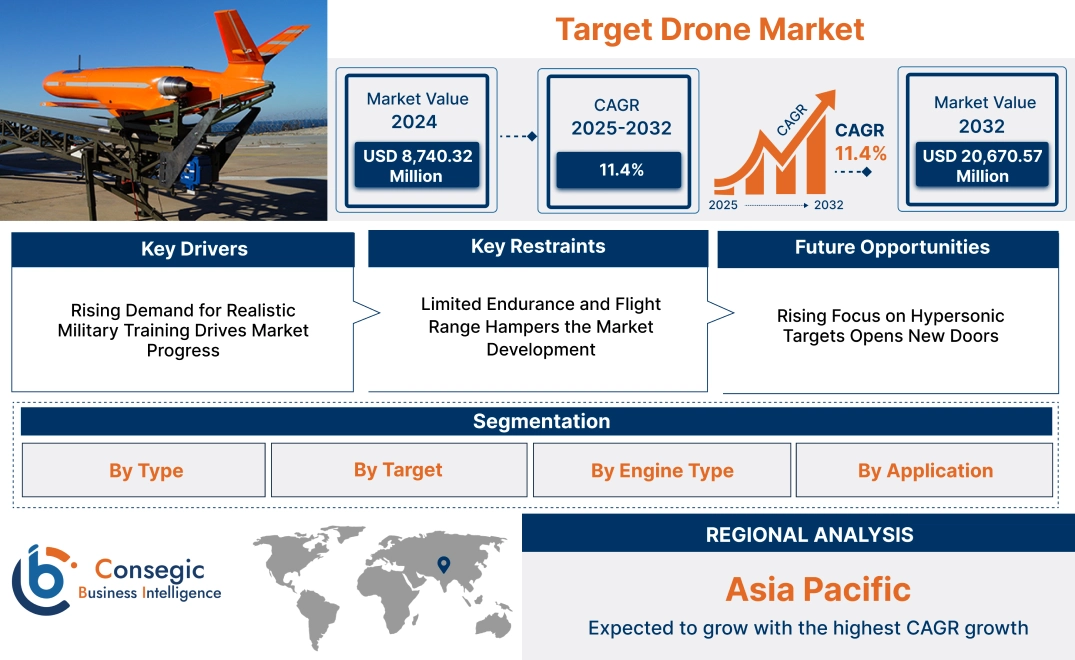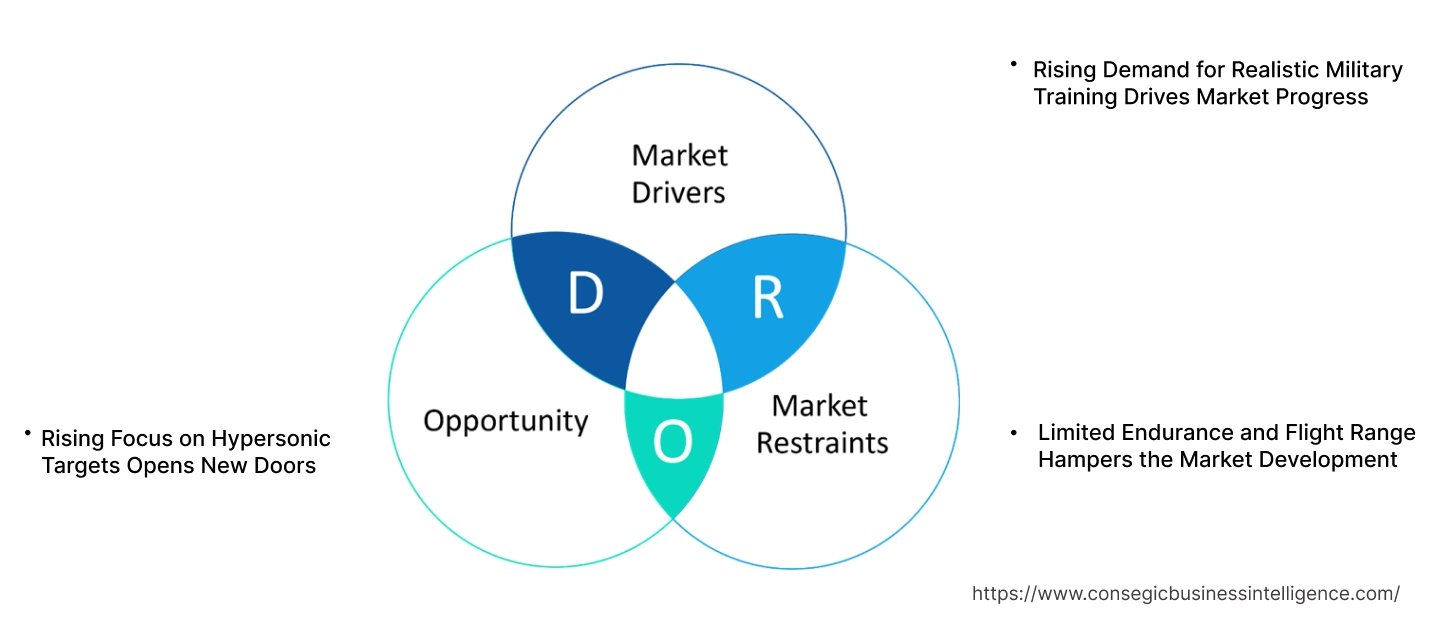- Summary
- Table Of Content
- Methodology
Target Drone Market Size:
Target Drone Market size is estimated to reach over USD 20,670.57 Million by 2032 from a value of USD 8,740.32 Million in 2024 and is projected to grow by USD 9,577.48 Million in 2025, growing at a CAGR of 11.4% from 2025 to 2032.
Target Drone Market Scope & Overview:
The target drone focuses on unmanned aerial vehicles designed to simulate real-world threats for training, testing, and research purposes. These drones are widely used by defense forces, aerospace industries, and weapon manufacturers to enhance the effectiveness of military training exercises and evaluate advanced weaponry systems. They serve as cost-effective and reusable platforms to replicate enemy aircraft or missile threats.
These drones come in various configurations, including high-speed, low-speed, and stealth models, tailored to meet diverse training and testing requirements. They are equipped with features like radar cross-section replication, advanced navigation systems, and payload capabilities to provide realistic simulations. These drones are built to withstand challenging conditions and deliver reliable performance during rigorous operational scenarios.
End-users include defense organizations, aerospace research institutions, and training facilities seeking efficient and realistic tools for combat readiness and weapons testing. They play a critical role in modern military preparedness and system development.
Key Drivers:
Rising Demand for Realistic Military Training Drives Market Progress
Armed forces worldwide are emphasizing the need for realistic and advanced training to prepare personnel for modern combat scenarios. Drones play a critical role in enhancing training realism by serving as dynamic aerial targets in simulations. These drones are utilized in various training exercises, including anti-aircraft defense and air-to-ground combat drills, providing an accurate representation of high-speed, maneuverable enemy aircraft. Their ability to replicate complex flight patterns and attack strategies enables soldiers to practice real-world engagement tactics safely and efficiently.
Moreover, drones offer a cost-effective alternative to live training with manned aircraft, reducing the risks and expenses associated with traditional methods. This capability to simulate diverse combat scenarios with precision has made drones an essential tool in military training programs, driving their adoption across defense forces globally. As military strategies evolve, the demand for drones to enhance combat readiness continues to rise, driving the target drone market growth.
Key Restraints:
Limited Endurance and Flight Range Hampers the Market Development
Drones often face issues related to limited endurance and flight range, primarily due to constraints in battery life or fuel capacity. These limitations become particularly evident during extended training exercises or testing missions that require prolonged or long-distance operations. For instance, drones used for military target simulation or testing advanced weapon systems need to operate continuously or over large areas, which their current power systems do not support.
As a result, their utility is restricted in scenarios requiring extended operational timelines, such as multi-phase drills or long-range reconnaissance simulations. These constraints not only hinder their effectiveness in critical applications but also limit the target drone market demand in sectors requiring high-performance and durable unmanned aerial systems. Addressing these endurance constraints is vital for enhancing the versatility and operational reliability of drones in diverse training and testing environments.
Future Opportunities :
Rising Focus on Hypersonic Targets Opens New Doors
The growing emphasis on hypersonic weapon systems has created a significant need for advanced drones capable of simulating these high-speed targets. Hypersonic systems travel at speeds exceeding Mach 5, making them exceptionally challenging to detect and intercept. To prepare for these threats, defense forces are incorporating drones that replicate the speed and maneuverability of hypersonic weapons in training exercises and testing scenarios. These drones enhance military preparedness by providing realistic simulations for tracking and interception drills.
The rising focus on hypersonic targets represents a critical opportunity for manufacturers to develop cutting-edge drone technologies, incorporating robust propulsion systems and advanced materials to withstand extreme speeds and conditions. As global defense strategies evolve to counter hypersonic threats, the demand for high-performance simulation drones is expected to drive innovation, creating significant target drone market opportunities.
Target Drone Market Segmental Analysis :
By Type:
Based on type, the market is segmented into fixed-wing target drones, rotary-wing target drones, and hybrid target drones.
The fixed-wing target drones segment accounted for the largest revenue of 51.3% of the total target drone market share in 2024.
- Fixed-wing target drones are widely used in military applications due to their ability to simulate realistic aerial threats during combat training.
- These drones offer extended flight endurance and higher speeds, making them ideal for reconnaissance and target acquisition missions.
- Their versatility in carrying diverse payloads such as cameras, sensors, and explosives enhances their operational efficiency.
- As per the segmental trends analysis, the dominance of this segment is supported by their extensive adoption across military training programs globally, contributing to the target drone market expansion.
The hybrid target drone segment is expected to register the fastest CAGR during the forecast period.
- Hybrid target drones combine the advantages of fixed-wing and rotary-wing designs, offering vertical take-off and landing capabilities.
- These drones are increasingly preferred for applications requiring high maneuverability and operational flexibility in confined spaces.
- Advancements in hybrid drone technology, including improved propulsion systems, contribute to their rising popularity in modern combat scenarios.
- As per the target drone market analysis, growth in investment of hybrid drones by defense organizations further accelerates the adoption of this segment.
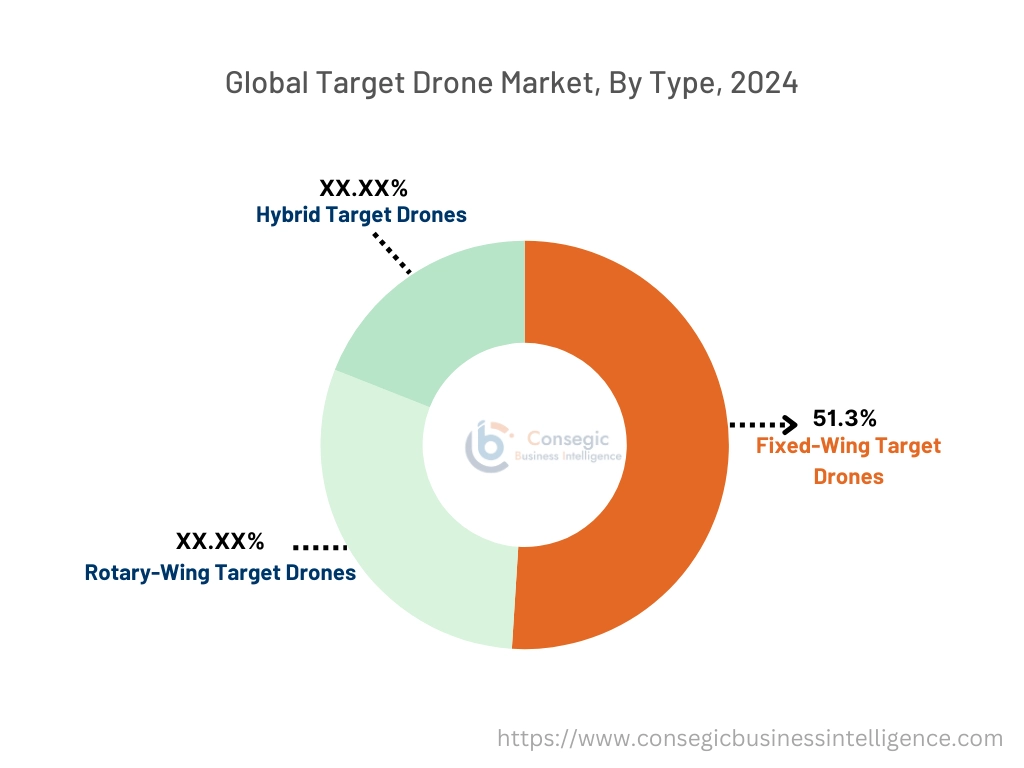
By Target:
Based on target, the market is segmented into aerial, ground, and marine.
The aerial target segment accounted for the largest revenue of the total target drone market share in 2024.
- Aerial targets are extensively utilized in simulating air threats for combat training and weapons testing.
- Their ability to replicate the behavior of advanced aerial threats, including UAVs and fighter jets, makes them crucial for defense strategies.
- These targets are equipped with sophisticated radar and sensor technologies, enhancing their effectiveness in military training.
- As per the target drone market trends, the widespread use of aerial targets across Air Force training programs solidifies the segment's dominance.
The marine target segment is expected to grow at the fastest CAGR during the forecast period.
- Marine targets are increasingly deployed for naval training exercises, including ship-to-ship combat scenarios.
- Their rising application in simulating enemy vessels and assessing missile system performance drives segment growth.
- Integration of advanced technologies like GPS and sonar in marine targets enhances their operational accuracy.
- Thus, the expansion of naval fleets and maritime security concerns bolster the adoption of marine target systems, driving the target drone market growth.
By Engine Type:
Based on engine type, the market is segmented into internal combustion engines, jet engines, turbojet engines, and others.
The internal combustion engine segment accounted for the largest revenue share in 2024.
- Drones with internal combustion engines are preferred for their cost-effectiveness and operational reliability in diverse environments.
- These engines provide sufficient power for long-duration missions, making them suitable for extensive training exercises.
- Their compatibility with a wide range of drone types and payloads enhances their demand in military applications.
- Therefore, the analysis of segmental trends portrays that the robust adoption of internal combustion engine drones across defense training programs supports segment dominance, fueling the target drone market demand.
The turbojet engine segment is expected to register the fastest CAGR during the forecast period.
- Turbojet engine drones offer superior speed and performance, replicating advanced aerial threats for realistic combat training.
- These drones are favored for high-altitude operations, including reconnaissance and surveillance missions.
- Advancements in turbojet technology, such as improved fuel efficiency and reduced noise levels, contribute to their growing adoption.
- Thus, increased investment in high-performance target drones by defense organizations propels the turbojet engine segment, contributing to the target drone market expansion.
By Application:
Based on application, the market is segmented into combat training, target acquisition, reconnaissance, and others.
The combat training segment accounted for the largest revenue share in 2024.
- Target drones are extensively used in combat training exercises to enhance soldier preparedness against aerial and ground threats.
- These drones simulate realistic combat scenarios, improving weapon system accuracy and operational tactics.
- Adoption of advanced drones equipped with radar and countermeasure systems bolsters their application in military training.
- As per the target drone market analysis, the dominance of this segment is driven by the continuous focus on modernizing combat training programs globally.
The reconnaissance segment is expected to grow at the fastest CAGR during the forecast period.
- Target drones are increasingly employed in reconnaissance missions to gather critical intelligence in conflict zones.
- Their ability to operate in high-risk environments and deliver real-time data enhances their application in defense operations.
- Integration of advanced imaging technologies, including infrared and thermal cameras, improves their reconnaissance capabilities.
- As per the target drone market trends, rising geopolitical tensions and the need for enhanced situational awareness fuel the growth of this segment.
Regional Analysis:
The regions covered are North America, Europe, Asia Pacific, the Middle East and Africa, and Latin America.
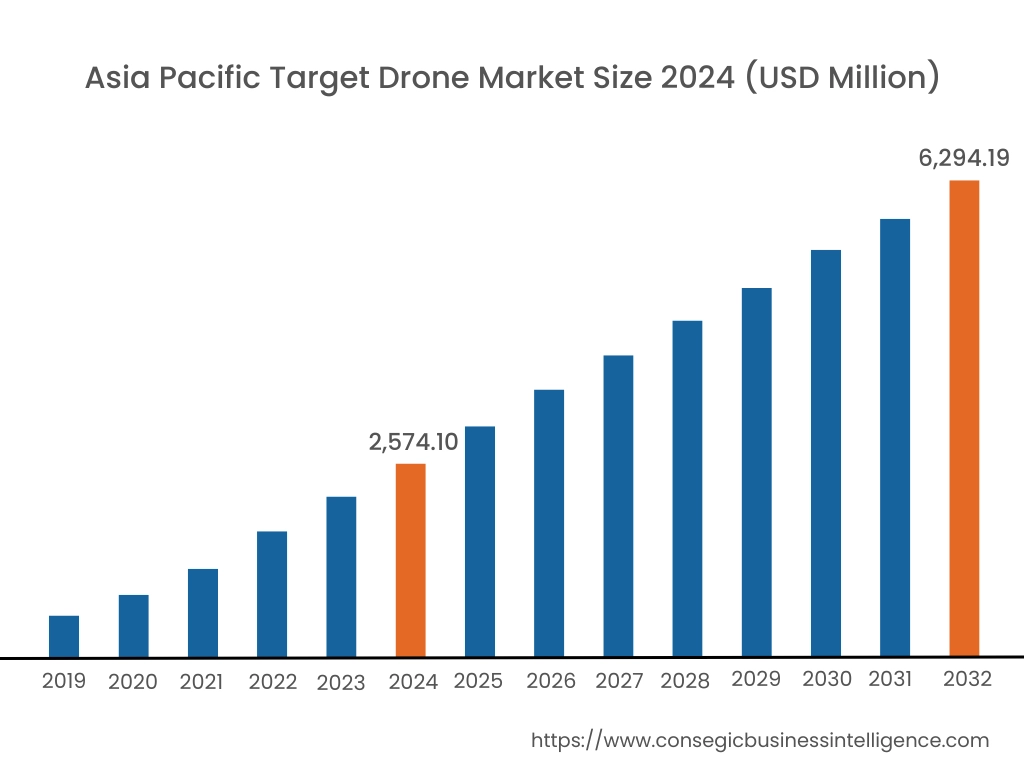
Asia Pacific region was valued at USD 2,574.10 Million in 2024. Moreover, it is projected to grow by USD 2,828.62 Million in 2025 and reach over USD 6,294.19 Million by 2032. Out of this, China accounted for the maximum revenue share of 31.8%. The Asia-Pacific region is witnessing a growing interest in target drones, driven by rising geopolitical tensions and the need to enhance military preparedness. Countries such as China, India, and Japan are investing in target drone technology to support extensive training exercises and defense system evaluations. A prominent trend is the development of indigenous target drone capabilities to reduce reliance on foreign technology. Analysis suggests that regional security concerns and defense modernization efforts are key factors influencing the target drone market opportunities.
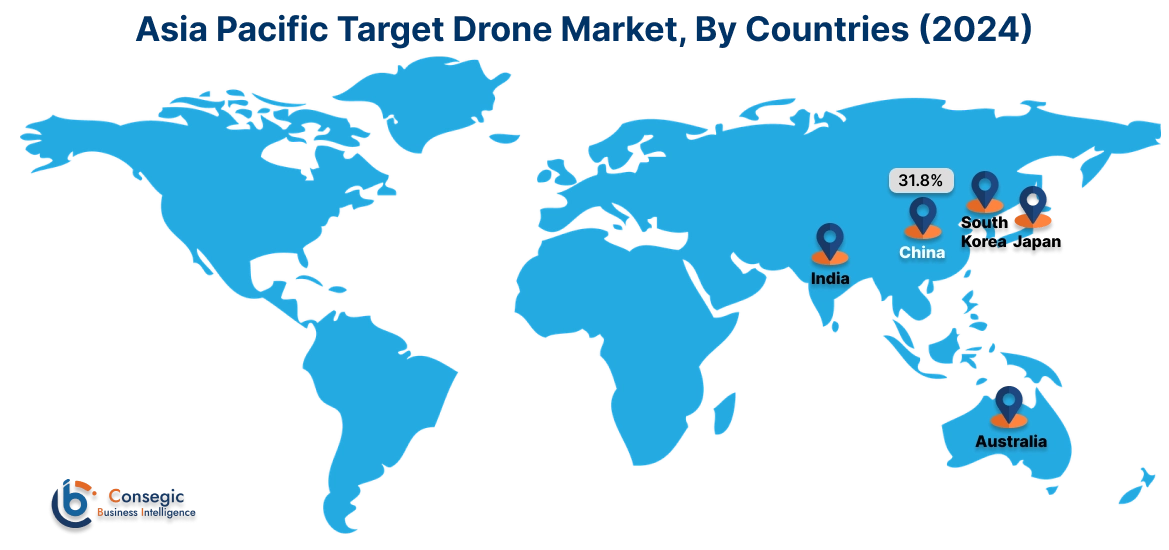
North America is estimated to reach over USD 6,699.33 Million by 2032 from a value of USD 2,899.24 Million in 2024 and is projected to grow by USD 3,170.86 Million in 2025. This region maintains a dominant position in the target drone market, largely due to substantial investments in unmanned aerial systems (UAS) research and development. The United States Department of Defense allocates significant resources to the development and procurement of target drones, emphasizing their role in realistic combat training and weapons testing. A notable trend is the integration of advanced technologies to enhance the performance and versatility of target drones. Analysis indicates that the focus on maintaining military superiority and readiness continues to drive the market growth in this region.
European nations, including Germany, France, and the United Kingdom, are actively investing in target drone technology to bolster their defense capabilities. The region's emphasis on modernizing military training programs has led to increased adoption of target drones for simulating realistic threat scenarios. A significant trend is the collaboration among European defense contractors to develop advanced target drone systems.
In the Middle East and Africa, there is a growth in recognition of the strategic importance of target drones for defense training and system testing. Nations are adopting target drone technology to enhance their military capabilities amidst regional conflicts and security challenges. A notable trend is the procurement of target drones to simulate various threat scenarios, aiding in the development of effective countermeasures.
Latin American countries are gradually exploring the use of target drones to strengthen their defense training programs. The focus on modernizing military capabilities has led to interest in target drones for realistic combat simulations. A significant trend is the collaboration with international defense firms to acquire and develop target drone technology.
Top Key Players and Market Share Insights:
The Target Drone market is highly competitive with major players providing products and services to the national and international markets. Key players are adopting several strategies in research and development (R&D), product innovation, and end-user launches to hold a strong position in the global Target Drone market. Key players in the Target Drone industry include -
- Northrop Grumman Corporation (USA)
- Lockheed Martin Corporation (USA)
- BAE Systems plc (UK)
- Airbus SE (Netherlands)
- Aerotargets International (Australia)
- The Boeing Company (USA)
- Kratos Defense & Security Solutions, Inc. (USA)
- Textron Inc. (USA)
- QinetiQ Group plc (UK)
- Leonardo S.p.A. (Italy)
Target Drone Market Report Insights :
| Report Attributes | Report Details |
| Study Timeline | 2019-2032 |
| Market Size in 2032 | USD 20,670.57 Million |
| CAGR (2025-2032) | 11.4% |
| By Type |
|
| By Target |
|
| By Engine Type |
|
| By Application |
|
| By Region |
|
| Key Players |
|
| North America | U.S. Canada Mexico |
| Europe | U.K. Germany France Spain Italy Russia Benelux Rest of Europe |
| APAC | China South Korea Japan India Australia ASEAN Rest of Asia-Pacific |
| Middle East and Africa | GCC Turkey South Africa Rest of MEA |
| LATAM | Brazil Argentina Chile Rest of LATAM |
| Report Coverage |
|
Key Questions Answered in the Report
What is the size of the Target Drone Market? +
The Target Drone Market size is estimated to reach over USD 20,670.57 Million by 2032 from a value of USD 8,740.32 Million in 2024 and is projected to grow by USD 9,577.48 Million in 2025, growing at a CAGR of 11.4% from 2025 to 2032.
What are the key segments in the Target Drone Market? +
The market is segmented by type (fixed-wing target drones, rotary-wing target drones, hybrid target drones), target (aerial, ground, marine), engine type (internal combustion engine, jet engine, turbojet engine, others), and application (combat training, target acquisition, reconnaissance, others).
Which segment is expected to grow the fastest in the Target Drone Market? +
The hybrid target drones segment is expected to grow at the fastest CAGR during the forecast period, driven by their ability to combine the advantages of fixed-wing and rotary-wing designs for greater maneuverability and operational flexibility.
Who are the major players in the Target Drone Market? +
Major players in the Target Drone Market include Northrop Grumman Corporation (USA), Lockheed Martin Corporation (USA), The Boeing Company (USA), Kratos Defense & Security Solutions, Inc. (USA), Textron Inc. (USA), QinetiQ Group plc (UK), Leonardo S.p.A. (Italy), BAE Systems plc (UK), Airbus SE (Netherlands), and Aerotargets International (Australia).
